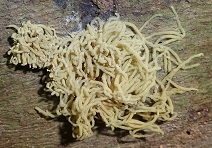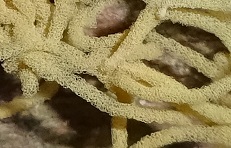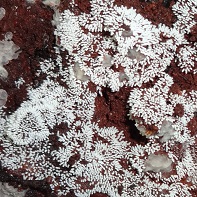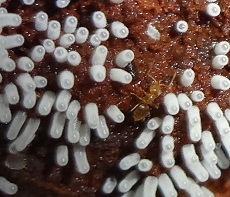| Home | Nature Weekly Index |
28 September 2014 | Golden Slime Mould | White Coral Slime Mould |
This month, while surveying a large horizontal log on the ground that was lined with some bracket mushrooms in a park, I saw a bundle of light yellow object hanging from the side. This log, a fallen trunk of a tree, was in that same location and position for a long time; probably more than a year. Many different mushrooms had come and go over the course of time. It was the same log that I found my first Chocolate Tube Slime Mould (Stemonitis sp.), which I had shared on 26 January.

 Equip prior knowledge on slime mould after browsing through some of their pictures in January, my primary suspect for this strange
light yellow object was a slime mould. After viewing its appearance in the enlarge pictures and doing the usual online search, my
suspicion was confirmed. Indeed, it was another slime mould, likely to be the
Golden Slime Mould (Arcyria nutans). This is a plasmodial slime moulds or
myxomycetes. A survey on myxomycetes in Singapore in 2009 yield 76 species in 26 genera including 36 species new to Singapore. The
finding was
published the Pacific Science journal in 2011.
Equip prior knowledge on slime mould after browsing through some of their pictures in January, my primary suspect for this strange
light yellow object was a slime mould. After viewing its appearance in the enlarge pictures and doing the usual online search, my
suspicion was confirmed. Indeed, it was another slime mould, likely to be the
Golden Slime Mould (Arcyria nutans). This is a plasmodial slime moulds or
myxomycetes. A survey on myxomycetes in Singapore in 2009 yield 76 species in 26 genera including 36 species new to Singapore. The
finding was
published the Pacific Science journal in 2011.

 While doing the online search, I came across a picture of a white clustered and pointed slime mould that resembled some pictures
taken by me in two previous occasions, January this year and August last year in two separate locations. After comparing the
pictures, the white mushroom-liked growth should be the
White Coral Slime Mold (Ceratiomyxa fruticulosa). I had
previously thought that it was a kind of coral mushroom from the family Clavariaceae. The White Coral Slime Mould is in the class
known as Protostelia, which is not the same class as the Golden Slime Mould.
While doing the online search, I came across a picture of a white clustered and pointed slime mould that resembled some pictures
taken by me in two previous occasions, January this year and August last year in two separate locations. After comparing the
pictures, the white mushroom-liked growth should be the
White Coral Slime Mold (Ceratiomyxa fruticulosa). I had
previously thought that it was a kind of coral mushroom from the family Clavariaceae. The White Coral Slime Mould is in the class
known as Protostelia, which is not the same class as the Golden Slime Mould.
Once upon a time, slime moulds were group under the mushrooms kingdom since they do look very similar to mushrooms and exist in similar habitat where mushroom thrived. The scientific terms and descriptions on slime moulds are quite complex to me. Nevertheless, I am glad to have several chances to look at these live specimen in the wild.
If you want to listen to something on slime mould without too much scientific jargon, there is an interesting 12-minute talk from a non-biologist (an artist) on the semi-intelligent slime mould, specifically Physarum polycephalum, in the TED website.